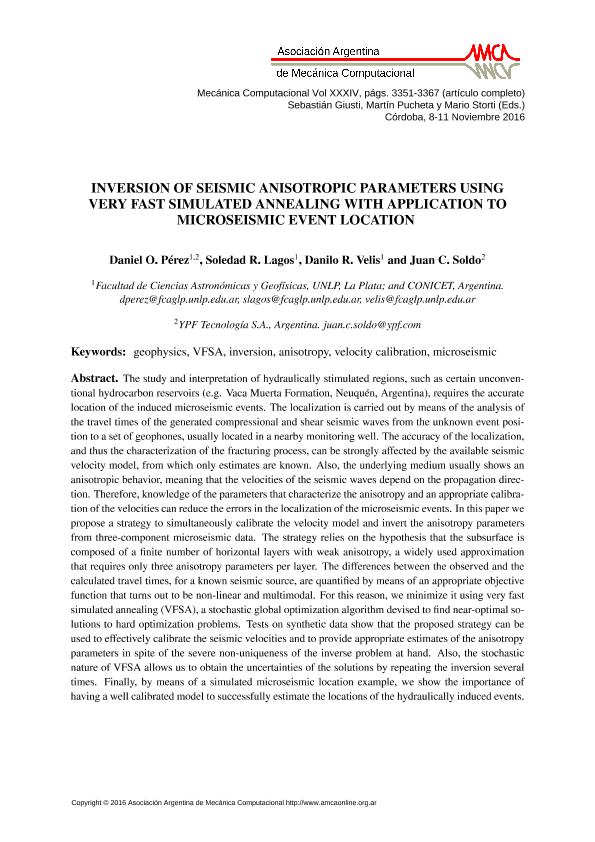Mostrar el registro sencillo del ítem
dc.contributor.author
Perez, Daniel Omar

dc.contributor.author
Lagos, Soledad Rocio

dc.contributor.author
Velis, Danilo Ruben

dc.contributor.author
Soldo, Juan Carlos

dc.date.available
2018-08-15T20:38:41Z
dc.date.issued
2016-11
dc.identifier.citation
Perez, Daniel Omar; Lagos, Soledad Rocio; Velis, Danilo Ruben; Soldo, Juan Carlos; Inversion of Seismic Anisotropic Parameters Using Very Fast Simulated Annealing with Application to Microseismic Event Location
; Asociación Argentina de Mecánica Computacional; Mecánica Computacional; XXXIV; 49; 11-2016; 3351-3367
dc.identifier.issn
2591-3522
dc.identifier.uri
http://hdl.handle.net/11336/55755
dc.description.abstract
The study and interpretation of hydraulically stimulated regions, such as certain unconventional hydrocarbon reservoirs (e.g. Vaca Muerta Formation, Neuquén, Argentina), requires the accurate location of the induced microseismic events. The localization is carried out by means of the analysis of the travel times of the generated compressional and shear seismic waves from the unknown event position to a set of geophones, usually located in a nearby monitoring well. The accuracy of the localization, and thus the characterization of the fracturing process, can be strongly affected by the available seismic velocity model, from which only estimates are known. Also, the underlying medium usually shows an anisotropic behavior, meaning that the velocities of the seismic waves depend on the propagation direction. Therefore, knowledge of the parameters that characterize the anisotropy and an appropriate calibration of the velocities can reduce the errors in the localization of the microseismic events. In this paper we propose a strategy to simultaneously calibrate the velocity model and invert the anisotropy parameters from three-component microseismic data. The strategy relies on the hypothesis that the subsurface is composed of a finite number of horizontal layers with weak anisotropy, a widely used approximation that requires only three anisotropy parameters per layer. The differences between the observed and the calculated travel times, for a known seismic source, are quantified by means of an appropriate objective function that turns out to be non-linear and multimodal. For this reason, we minimize it using very fast simulated annealing (VFSA), a stochastic global optimization algorithm devised to find near-optimal solutions to hard optimization problems. Tests on synthetic data show that the proposed strategy can be used to effectively calibrate the seismic velocities and to provide appropriate estimates of the anisotropy parameters in spite of the severe non-uniqueness of the inverse problem at hand. Also, the stochastic nature of VFSA allows us to obtain the uncertainties of the solutions by repeating the inversion several times. Finally, by means of a simulated microseismic location example, we show the importance of having a well calibrated model to successfully estimate the locations of the hydraulically induced events.
dc.format
application/pdf
dc.language.iso
eng
dc.publisher
Asociación Argentina de Mecánica Computacional
dc.rights
info:eu-repo/semantics/openAccess
dc.rights.uri
https://creativecommons.org/licenses/by-nc-sa/2.5/ar/
dc.subject
Anisotropy
dc.subject
Microseismic
dc.subject
Velocity Calibration
dc.subject
Vfsa
dc.subject.classification
Meteorología y Ciencias Atmosféricas

dc.subject.classification
Ciencias de la Tierra y relacionadas con el Medio Ambiente

dc.subject.classification
CIENCIAS NATURALES Y EXACTAS

dc.title
Inversion of Seismic Anisotropic Parameters Using Very Fast Simulated Annealing with Application to Microseismic Event Location
dc.type
info:eu-repo/semantics/article
dc.type
info:ar-repo/semantics/artículo
dc.type
info:eu-repo/semantics/publishedVersion
dc.date.updated
2018-08-13T14:48:08Z
dc.journal.volume
XXXIV
dc.journal.number
49
dc.journal.pagination
3351-3367
dc.journal.pais
Argentina

dc.description.fil
Fil: Perez, Daniel Omar. YPF - Tecnología; Argentina. Universidad Nacional de La Plata. Facultad de Ciencias Astronómicas y Geofísicas; Argentina. Consejo Nacional de Investigaciones Científicas y Técnicas; Argentina
dc.description.fil
Fil: Lagos, Soledad Rocio. Universidad Nacional de La Plata. Facultad de Ciencias Astronómicas y Geofísicas; Argentina. Consejo Nacional de Investigaciones Científicas y Técnicas; Argentina
dc.description.fil
Fil: Velis, Danilo Ruben. Universidad Nacional de La Plata. Facultad de Ciencias Astronómicas y Geofísicas; Argentina. Consejo Nacional de Investigaciones Científicas y Técnicas; Argentina
dc.description.fil
Fil: Soldo, Juan Carlos. YPF - Tecnología; Argentina. Universidad Nacional de La Plata. Facultad de Ciencias Astronómicas y Geofísicas; Argentina
dc.journal.title
Mecánica Computacional

dc.relation.alternativeid
info:eu-repo/semantics/altIdentifier/url/https://cimec.org.ar/ojs/index.php/mc/article/view/5208
Archivos asociados
